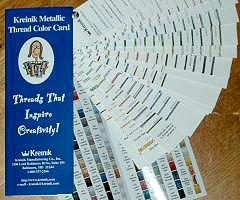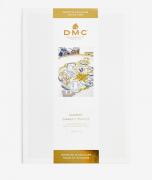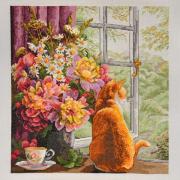Metallic threads, second episode: the Kreiniks

Hello everybody! In one of our last posts we have decided to consacrate some time to metallic threads: maybe because it's Christmas time or maybe because there is no embroiderer who once in her life has not tested this type of threads which, even if they have some lacks, give a lot of light to all your works!
Of course, among the best-sellers of this category there are the famous Kreiniks.
Let's get closer to them.
These threads are produced, from the 70s in the USA by a family enterprise, funded at that time by Estelle, who was of course fond of embroidery and by her husband. They started their family work together as you can see here:
Our Kreinik offer has 6 references: of them, 5 are metallic threads. If some of you are wondering how we can use these threads and why the choice is so wide, here is a quick guide that, I hope, will help you with your works with the metallic threads!
But let's start with the Blending Filament:
This thread has only one ply, so it is not divisible and it can be used alone or with another thread, like the classic mouliné or other woolen threads! It's ideal for the handwork, but it can be also used for machine embroidery and for the crochet. It can be washed with the water or dry. When you use it with other threads, a good system in order to "melt" the two plies is to wet with a sponge, like those we use for the makeup. When you start your embroidery you'd better try to maintain the thread always in the same sense because this will make our work more brilliant. Another piece of advice: think about it as a little ribbon which, sometimes, you have to spread out with the fingertip of your index!
As for all the other metallic threads, furthermore, we have to remember to use short needlefuls - half a metre- and to let the needle dangle a bit so that any eventual twisting is automatically eliminated. Then the needle should be big enough so that we can open the fabric any time we pass it through: this will avoid a strong friction between the fibers of your fabric and those of the thread

All this is right also for the two "Fine Braid": the 8 and the 4
Also these two metallic threads have one ply and they differ for the consistency: the 4 is finer than the 8 and they can be used differently: the 8 for the cross-stitch or the blackwork, and the 4 for the finest details like a woman's glittering eyes, the light of the water or the white snow in winter. Do not forget that these two Kreinik can also be used for the patchwork and the l’appliqué, also with the machine, whatever the version you will try: the “Basic” – the fundamental one –, the “Hi Lustre”,which is very brilliant, the “Glow in the Dark”, almost fluo and visible in the dark, the "Vintage", perfect for those who love the effect of the past years.
The Kreinik Cable is instead a real little twisted rope, ideal for giving a tridimensional effect to some details of the cross-stitching or, once again, other types of embroidery like the needlepoint, the backs and the hems, but also the scrapbooking. As for this particular thread, the most useful suggestion is to embroider very slowly: the result will be surprisingly brilliant. Well, it is worthed to be patient

I steal a bit of your time for the Kreinik Japan Threads: these are synthetical and brilliant threads which distinguish themselves for their smooth and pleasant consistency, both for the touch and for the view! Their appearance is that of gold, silver and copper and also for this reason they are the best choice for those who love the most researched embroideries. Like those of the ecclesiastic dresses or the tablecloths for the altars, made with cross-stitch or needlepoint or other techniques. Only one more piece of advice: the Japan Threads can be only dry washed!
I hope I've given you some good pieces of advice about the metallic threads! I'm waiting for your questions and impressions

A big hug and happy stitching!

 English
English Français
Français Español
Español Italiano
Italiano



































